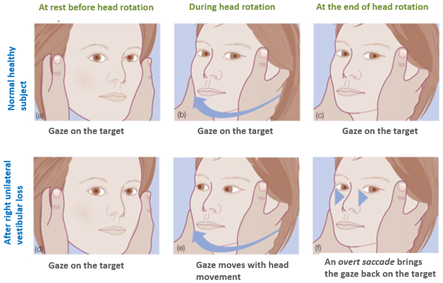Main advantages of vHIT (Video Head Impulse Test) compared to cHIT (Clinical Head Impulse Test)
In 1988, Gabor M. Halmagyi and Ian S. Curthoys introduced the Head Impulse Test (HIT) for the first time. In this test, the patient focuses on the examiner's nose tip while experiencing rapid, unpredictable, and rebound-free head movements. Its primary goal is to assess the canal function during high-velocity head rotations.
For healthy individuals, their gaze remains steady at the end of head rotation due to a valid vestibular-oculomotor reflex (VOR), which counter-rotates the eyes. Visual information becomes irrelevant for gaze stabilization during high-velocity head rotations due to the limitations of visual tracking and optokinetic reflex.
In pathological cases with impaired VOR, a rapid eye movement called a refixation saccade occurs at the end of head rotation, as the expected eye counter-rotation doesn't happen. This results in a positive test.

However, Halmagyi's clinical test has limitations:
- It provides an "all or nothing" response, incapable of assessing intermediate deficits.
- Corrective saccades (overt saccades) appearing at the end of head movement are not the only compensatory responses; there are covert saccades that are invisible to the naked eye.
This led to the development of vHIT (Video Head Impulse Test) devices.
vHIT examines the vestibular-oculomotor reflex (VOR) through high-velocity impulsive head movements, recording both eye and head movements. Key parameters include gain (ratio of eye to head movement) and analysis of corrective saccades (latency, amplitude, velocity). Normal parameter values can vary among canal systems. Covert saccades are detectable only with vHIT, while overt saccades can be assessed with bedside tests and vHIT.
vHIT offers advantages: ease and speed of execution, minimal patient discomfort, suitability for ambient lighting, analysis of vertical canals, and use of a stimulus with physiological labyrinthine characteristics.
In summary, cHIT is positive only in severe deficits, lacking the ability to quantify partial dysfunctions and relying on examiner experience. In contrast, vHIT quantifies deficits continuously, providing an objective method for verifying compensation strategies, significantly impacting rehabilitation.



 Go to the top
Go to the top

 International - English
International - English Italia - Italiano
Italia - Italiano France - Français
France - Français USA - English
USA - English